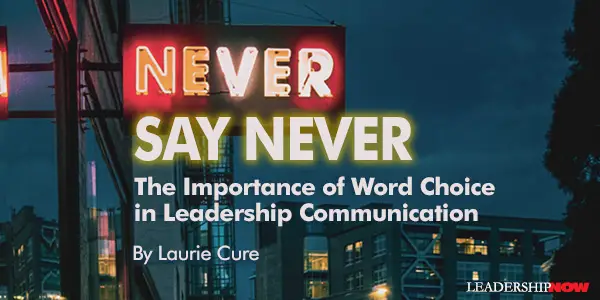 |
 |
05.03.21

Never Say Never: The Importance of Word Choice in Leadership Communication
LANGUAGE matters. As I conduct observation coaching with leaders, I watch for how their words resonate with their audience. Does what they say induce fear? Excitement? Do attendees in the meeting cringe at certain words, or do their metaphors generate inspiration? Effective leaders use communication as a critical competency to build trusting relationships, align team members around a vision, lead necessary change, and drive action. Communication involves verbal, non-verbal, and intuitive delivery and receiving of messages. It also requires listening and speaking with intention. In support of that, the communication process typically involves five critical steps.
Any missteps, gaps, or errors in these stages can lead to a serious breakdown in the communication cycle. It can destroy relationships, damage trust, and contribute to adverse impacts on business outcomes. In medicine, law enforcement, education, and almost every profession, communication failures lead to lasting negative impacts. The best leaders maneuver these five steps in a way that leaves their teams feeling heard, understood, and valued. To accomplish this, leaders have a responsibility to ensure they are appropriately using every step of the communication cycle to deliver an accurate message. Effective communication is difficult for a variety of reasons. Our lack of knowledge around cultural differences, as well as human factors such as stress, fatigue, and communication skills, all play a role in the potential breakdown of communication. Today, there is an emphasis on rapid decision making, and fast-paced problem solving that often involve many parties and differing perspectives. Given these variables, there are several things to keep in mind to avoid communication breakdown. 1. Avoid Certain Words There are words that create a negative emotional reaction regardless of the intent behind the word. We certainly do not need to eliminate all these words, but carefully considering your purpose, tone, and the desired reaction can ensure these words do not leave others frustrated or disengaged.
2. Be Cautious When Using Idioms I have made this mistake too many times to count. Recently, I met with a partner from France. I used the idiom, “let me put a bug in your ear,” to share an idea I wanted her to consider. That phrase was unfamiliar to her, and my intention was lost on her. While idioms seem helpful to make a point, there is also a significant risk that they originated and have a history that is different than your intention in today's world. Ethic, cultural, racial, or religious idioms that were accepted and used in the past may no longer be appropriate today. 3. Avoid Absolutes “Nobody does it better,” or “I have the best employee/team.” Again, while this is often used to elevate those close to us, it generally has the effect of alienating others and diminishing their skills and abilities. Additionally, terms like all, none, must, never, only, always can be hooks. They have no exceptions and do not leave room for error or discussion. They can be taken as condensing and make others feel inferior. The words we use matter, especially in a leadership role where our teams regularly react and listen closely to what we share. Start paying attention to the reactions you receive when speaking and cut out the words and phrases that are spurring a negative response. 
Posted by Michael McKinney at 09:25 AM
|
BUILD YOUR KNOWLEDGE
 

How to Do Your Start-Up Right STRAIGHT TALK FOR START-UPS 
Grow Your Leadership Skills NEW AND UPCOMING LEADERSHIP BOOKS 
Leadership Minute BITE-SIZE CONCEPTS YOU CAN CHEW ON 
Classic Leadership Books BOOKS TO READ BEFORE YOU LEAD |